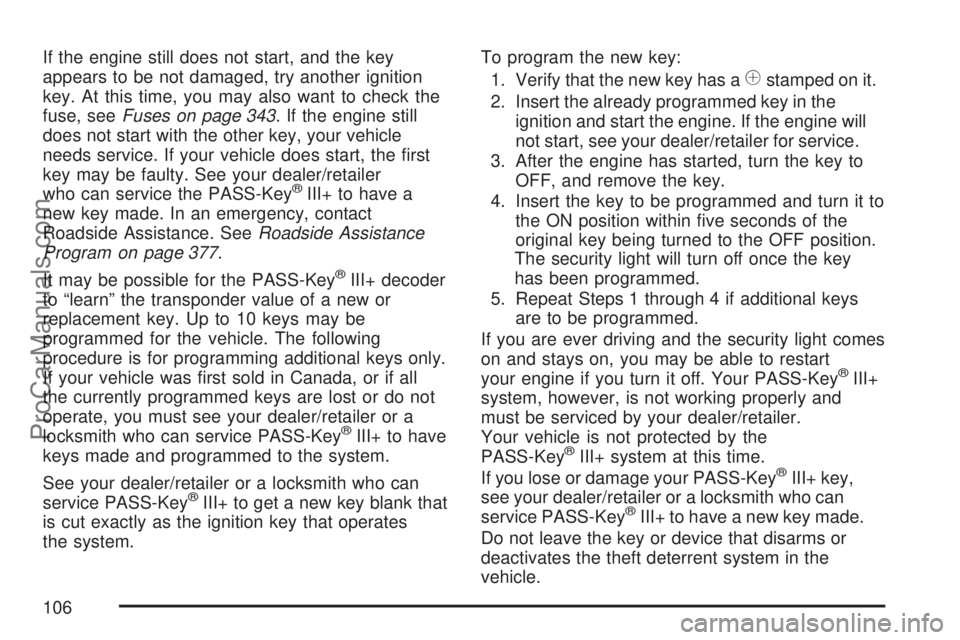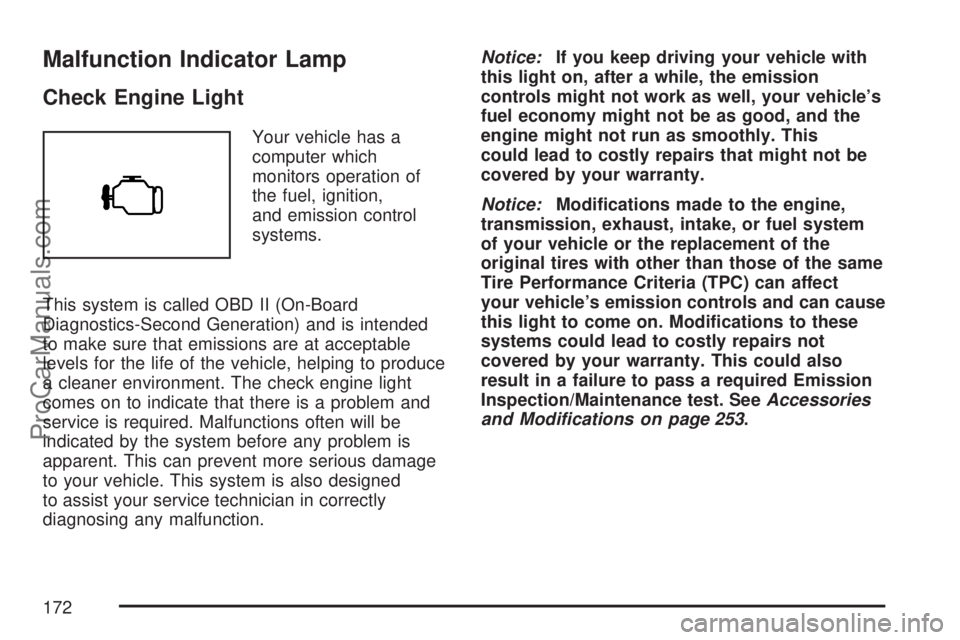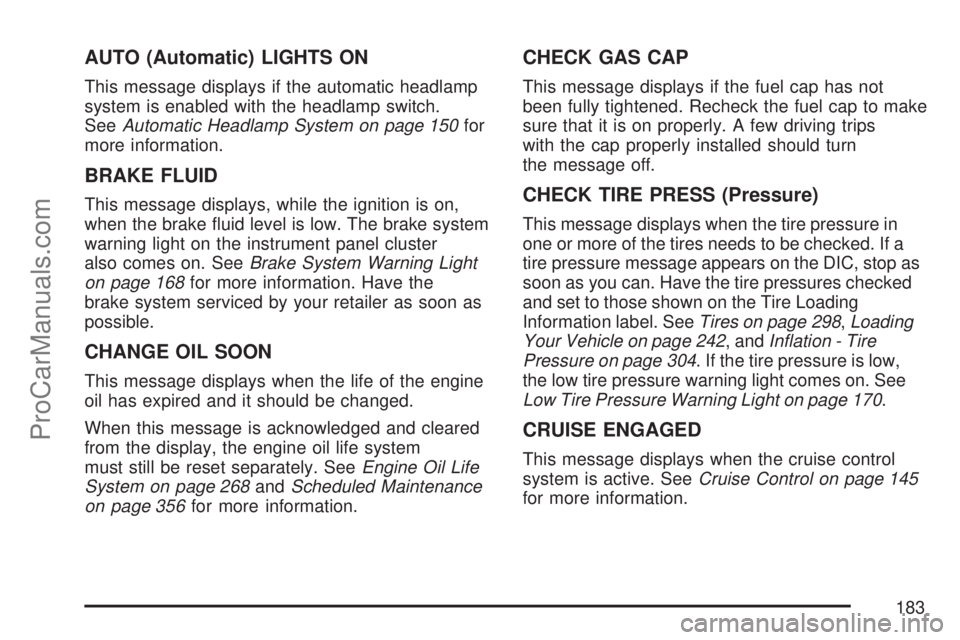check engine SATURN AURA 2007 Owners Manual
[x] Cancel search | Manufacturer: SATURN, Model Year: 2007, Model line: AURA, Model: SATURN AURA 2007Pages: 406, PDF Size: 6.49 MB
Page 106 of 406

If the engine still does not start, and the key
appears to be not damaged, try another ignition
key. At this time, you may also want to check the
fuse, seeFuses on page 343. If the engine still
does not start with the other key, your vehicle
needs service. If your vehicle does start, the �rst
key may be faulty. See your dealer/retailer
who can service the PASS-Key
®III+ to have a
new key made. In an emergency, contact
Roadside Assistance. SeeRoadside Assistance
Program on page 377.
It may be possible for the PASS-Key
®III+ decoder
to “learn” the transponder value of a new or
replacement key. Up to 10 keys may be
programmed for the vehicle. The following
procedure is for programming additional keys only.
If your vehicle was �rst sold in Canada, or if all
the currently programmed keys are lost or do not
operate, you must see your dealer/retailer or a
locksmith who can service PASS-Key
®III+ to have
keys made and programmed to the system.
See your dealer/retailer or a locksmith who can
service PASS-Key
®III+ to get a new key blank that
is cut exactly as the ignition key that operates
the system.To program the new key:
1. Verify that the new key has a
1stamped on it.
2. Insert the already programmed key in the
ignition and start the engine. If the engine will
not start, see your dealer/retailer for service.
3. After the engine has started, turn the key to
OFF, and remove the key.
4. Insert the key to be programmed and turn it to
the ON position within �ve seconds of the
original key being turned to the OFF position.
The security light will turn off once the key
has been programmed.
5. Repeat Steps 1 through 4 if additional keys
are to be programmed.
If you are ever driving and the security light comes
on and stays on, you may be able to restart
your engine if you turn it off. Your PASS-Key
®III+
system, however, is not working properly and
must be serviced by your dealer/retailer.
Your vehicle is not protected by the
PASS-Key
®III+ system at this time.
If you lose or damage your PASS-Key®III+ key,
see your dealer/retailer or a locksmith who can
service PASS-Key
®III+ to have a new key made.
Do not leave the key or device that disarms or
deactivates the theft deterrent system in the
vehicle.
106
ProCarManuals.com
Page 111 of 406

Notice:Cranking the engine for long periods
of time, by returning the key to the START
position immediately after cranking has ended,
can overheat and damage the cranking
motor, and drain the battery. Wait at least
15 seconds between each try, to let the
cranking motor cool down.
2. If the engine does not start after 5-10 seconds,
especially in very cold weather (below 0°F
or−18°C), it could be �ooded with too much
gasoline. Try pushing the accelerator
pedal all the way to the �oor and holding it
there as you hold the key in START for up to
a maximum of 15 seconds. Wait at least
15 seconds between each try, to allow the
cranking motor to cool down. When the enginestarts, let go of the key and accelerator. If the
vehicle starts brie�y but then stops again,
do the same thing. This clears the extra
gasoline from the engine. Do not race the
engine immediately after starting it. Operate
the engine and transaxle gently until the
oil warms up and lubricates all moving parts.
Notice:Your engine is designed to work with
the electronics in your vehicle. If you add
electrical parts or accessories, you could
change the way the engine operates. Before
adding electrical equipment, check with
your retailer. If you do not, your engine might
not perform properly. Any resulting damage
would not be covered by your vehicle’s
warranty.
111
ProCarManuals.com
Page 161 of 406

Warning Lights, Gages, and
Indicators
This part describes the warning lights and gages
on your vehicle.
Warning lights and gages can signal that
something is wrong before it becomes serious
enough to cause an expensive repair or
replacement. Paying attention to the warning lights
and gages could also save you or others from
injury.
Warning lights come on when there may be or is a
problem with one of your vehicle’s functions. As
the details show on the next few pages, some
warning lights come on brie�y when you start the
engine just to let you know they are working. If
you are familiar with this section, you should
not be alarmed when this happens.Gages can indicate when there may be or is a
problem with one of your vehicle’s functions. Often
gages and warning lights work together to let
you know when there is a problem with your
vehicle.
When one of the warning lights comes on and
stays on as you are driving, or when one of
the gages shows there may be a problem, check
the section that tells you what to do about it.
Please follow this manual’s advice. Waiting to do
repairs can be costly and even dangerous. So
please get to know your vehicle’s warning
lights and gages. They can be a big help.
161
ProCarManuals.com
Page 167 of 406

If the word OFF or the off symbol is lit on the
airbag status indicator, it means that the
passenger sensing system has turned off the right
front passenger’s frontal airbag and seat-mounted
side impact airbag. SeePassenger Sensing
System on page 77for more on this, including
important safety information.
If, after several seconds, all status indicator lights
remain on, or if there are no lights at all, there
may be a problem with the lights or the passenger
sensing system. See your retailer for service.
{CAUTION:
If the off indicator and the airbag
readiness light ever come on together, it
means that something may be wrong with
the airbag system. If this ever happens,
have the vehicle serviced promptly,
because an adult-size person sitting in the
right front passenger seat may not have
the protection of the airbags. SeeAirbag
Readiness Light on page 164.
Charging System Light
The charging system
light will come on for a
few seconds when
you turn on the ignition
as a check to indicate
it is working.
If the light stays on, or comes on while you are
driving and you hear a chime, there could be
a problem with the electrical charging system. This
could indicate that there is a loose generator
drive belt or another electrical problem. Have it
checked right away. Driving while this light
is on could drain the battery and result in the
engine and headlights suddenly shutting off.
If you must drive a short distance with this light
on, turn off accessories, such as the radio,
air conditioner and heater fan.
167
ProCarManuals.com
Page 171 of 406

Electronic Stability Control Indicator
Light
Your vehicle may have
the Electronic Stability
Control (ESC) system.
You may feel or hear the system working, this is
normal. SeeElectronic Stability Control on
page 219for more information.
When the ESC indicator light is on and either the
SERVICE ESC or ESC OFF Driver Information
Center (DIC) message is displayed, the system will
not assist the driver to maintain directional
control of the vehicle. Adjust your driving
accordingly. SeeDIC Warnings and Messages on
page 182for more information.
Engine Coolant Temperature
Warning Light
This light indicates that
the engine coolant has
overheated or the
radiator cooling fan is
not working.
This light will come on brie�y when you turn on
the ignition as a check to show you it is working.
If the light comes on and the vehicle has been
operating under normal driving conditions, pull off
the road, stop the vehicle, and turn off the
engine as soon as possible.
SeeCooling System on page 278for more
information.
171
ProCarManuals.com
Page 172 of 406

Malfunction Indicator Lamp
Check Engine Light
Your vehicle has a
computer which
monitors operation of
the fuel, ignition,
and emission control
systems.
This system is called OBD II (On-Board
Diagnostics-Second Generation) and is intended
to make sure that emissions are at acceptable
levels for the life of the vehicle, helping to produce
a cleaner environment. The check engine light
comes on to indicate that there is a problem and
service is required. Malfunctions often will be
indicated by the system before any problem is
apparent. This can prevent more serious damage
to your vehicle. This system is also designed
to assist your service technician in correctly
diagnosing any malfunction.Notice:If you keep driving your vehicle with
this light on, after a while, the emission
controls might not work as well, your vehicle’s
fuel economy might not be as good, and the
engine might not run as smoothly. This
could lead to costly repairs that might not be
covered by your warranty.
Notice:Modi�cations made to the engine,
transmission, exhaust, intake, or fuel system
of your vehicle or the replacement of the
original tires with other than those of the same
Tire Performance Criteria (TPC) can affect
your vehicle’s emission controls and can cause
this light to come on. Modi�cations to these
systems could lead to costly repairs not
covered by your warranty. This could also
result in a failure to pass a required Emission
Inspection/Maintenance test. SeeAccessories
and Modifications on page 253.
172
ProCarManuals.com
Page 173 of 406

This light should come on, as a check to show
you it is working, when the ignition is on and the
engine is not running. If the light does not
come on, have it repaired. This light will also
come on during a malfunction in one of two ways:
Light Flashing— A mis�re condition has
been detected. A mis�re increases vehicle
emissions and could damage the emission
control system on your vehicle. Diagnosis and
service might be required.
Light On Steady— An emission control
system malfunction has been detected on your
vehicle. Diagnosis and service might be
required.
If the Light is Flashing
The following can prevent more serious damage
to your vehicle:
Reduce vehicle speed.
Avoid hard accelerations.
Avoid steep uphill grades.
If the light stops �ashing and remains on steady,
see “If the Light Is On Steady” following.If the light continues to �ash, when it is safe to do
so, stop the vehicle. Find a safe place to park
the vehicle. Turn the key off, wait at least
10 seconds, and restart the engine. If the light
remains on steady, see “If the Light Is On Steady”
following. If the light is still �ashing, follow the
previous steps and see your dealer/retailer
for service as soon as possible.
If the Light Is On Steady
You might be able to correct the emission system
malfunction by considering the following:
Did you recently put fuel into your vehicle?
If so, reinstall the fuel cap, making sure to fully
install the cap. SeeFilling the Tank on page 258.
The diagnostic system can determine if the
fuel cap has been left off or improperly installed. A
loose or missing fuel cap allows fuel to evaporate
into the atmosphere. A few driving trips with
the cap properly installed should turn the light off.
173
ProCarManuals.com
Page 174 of 406

Did you just drive through a deep puddle of
water?
If so, your vehicle’s electrical system might be
wet. The condition is usually corrected when the
electrical system dries out. A few driving trips
should turn the light off.
Have you recently changed brands of fuel?
If so, be sure to fuel your vehicle with quality fuel.
SeeGasoline Octane on page 255. Poor fuel
quality causes the engine not to run as efficiently
as designed. You might notice this as stalling
after start-up, stalling when you put the vehicle into
gear, mis�ring, hesitation on acceleration, or
stumbling on acceleration — these conditions
might go away once the engine is warmed up. This
will be detected by the system and cause the
light to turn on.
If you experience one or more of these conditions,
change the fuel brand you use. It will require at
least one full tank of the proper fuel to turn the
light off.
If none of the above steps have made the light
turn off, your dealer/retailer can check the vehicle.
Your dealer/retailer has the proper test equipment
and diagnostic tools to �x any mechanical or
electrical problems that might have developed.Emissions Inspection and Maintenance
Programs
Some state/provincial and local governments have
or might begin programs to inspect the emission
control equipment on your vehicle. Failure to pass
this inspection could prevent you from getting a
vehicle registration.
Here are some things you need to know to help
your vehicle pass an inspection:
Your vehicle will not pass this inspection if the
check engine light is on or not working properly.
Your vehicle will not pass this inspection if
the OBD (on-board diagnostic) system determines
that critical emission control systems have not
been completely diagnosed by the system.
The vehicle would be considered not ready for
inspection. This can happen if you have recently
replaced the battery or if the battery has run
down. The diagnostic system is designed
to evaluate critical emission control systems
during normal driving. This can take several days
of routine driving. If you have done this and
your vehicle still does not pass the inspection for
lack of OBD system readiness, your dealer/retailer
can prepare the vehicle for inspection.
174
ProCarManuals.com
Page 175 of 406

Oil Pressure Light
If your vehicle has low
engine oil pressure, this
light will stay on after
you start your engine, or
come on and you will
hear a chime when you
are driving.
This indicates that your engine is not receiving
enough oil. The engine could be low on oil,
or could have some other oil problem. Have it
�xed immediately.
This light will come on brie�y when you turn on
the ignition as a check to show you it is working. If
it does not come on with the ignition on, you
may have a problem with the bulb. Have it �xed
right away.{CAUTION:
Do not keep driving if the oil pressure is
low. If you do, your engine can become so
hot that it catches �re. You or others
could be burned. Check your oil as soon
as possible and have your vehicle
serviced.
Notice:Lack of proper engine oil maintenance
may damage the engine. The repairs would
not be covered by your warranty. Always follow
the maintenance schedule in this manual for
changing engine oil.
175
ProCarManuals.com
Page 183 of 406

AUTO (Automatic) LIGHTS ON
This message displays if the automatic headlamp
system is enabled with the headlamp switch.
SeeAutomatic Headlamp System on page 150for
more information.
BRAKE FLUID
This message displays, while the ignition is on,
when the brake �uid level is low. The brake system
warning light on the instrument panel cluster
also comes on. SeeBrake System Warning Light
on page 168for more information. Have the
brake system serviced by your retailer as soon as
possible.
CHANGE OIL SOON
This message displays when the life of the engine
oil has expired and it should be changed.
When this message is acknowledged and cleared
from the display, the engine oil life system
must still be reset separately. SeeEngine Oil Life
System on page 268andScheduled Maintenance
on page 356for more information.
CHECK GAS CAP
This message displays if the fuel cap has not
been fully tightened. Recheck the fuel cap to make
sure that it is on properly. A few driving trips
with the cap properly installed should turn
the message off.
CHECK TIRE PRESS (Pressure)
This message displays when the tire pressure in
one or more of the tires needs to be checked. If a
tire pressure message appears on the DIC, stop as
soon as you can. Have the tire pressures checked
and set to those shown on the Tire Loading
Information label. SeeTires on page 298,Loading
Your Vehicle on page 242, andIn�ation - Tire
Pressure on page 304. If the tire pressure is low,
the low tire pressure warning light comes on. See
Low Tire Pressure Warning Light on page 170.
CRUISE ENGAGED
This message displays when the cruise control
system is active. SeeCruise Control on page 145
for more information.
183
ProCarManuals.com